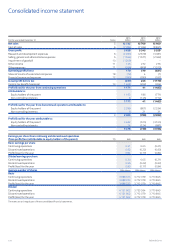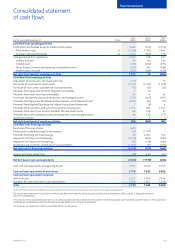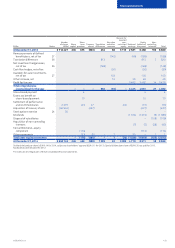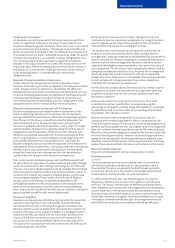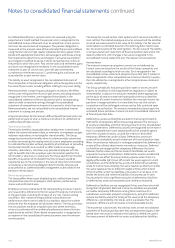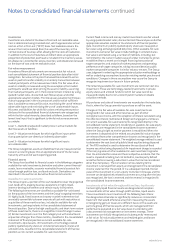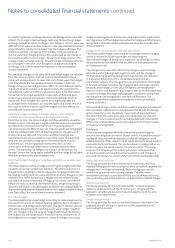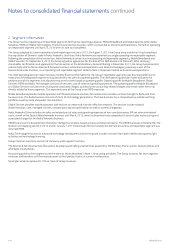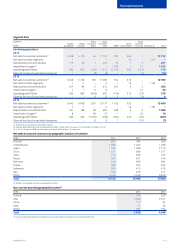Nokia 2014 Annual Report Download - page 133
Download and view the complete annual report
Please find page 133 of the 2014 Nokia annual report below. You can navigate through the pages in the report by either clicking on the pages listed below, or by using the keyword search tool below to find specific information within the annual report.
131
Financial statements
NOKIA IN 2014
Investment in associates
An associate is an entity over which the Group exercises signicant
inuence. Signicant inuence is the power to participate in the
nancial and operating policy decisions of the entity, but is not control
or joint control over those policies. The Group’s share of prots and
losses of associates is included in the consolidated income statement
in accordance with the equity method of accounting. Under the equity
method, the investment in an associate is initially recognized at cost.
The carrying amount of the investment is adjusted to recognize
changes in the Group’s share of net assets of the associate since the
acquisition date. After the carrying amount of the Group’s interest is
reduced to nil, in case of a loss-making investment, losses continue
to be recognized when it is considered that a constructive
obligation exists.
Disposal of separate entities or businesses
If upon disposal the Group loses control of a separate entity or
business, it records a gain or loss on disposal at the date when control
is lost. The gain or loss on disposal is calculated as the dierence
between the fair value of the consideration received and the carrying
amounts of derecognized assets and liabilities of the disposed entity
or business attributable to the equity holders of the parent and
non-controlling interest, adjusted by amounts recognized in other
comprehensive income in relation to that entity or business.
Discontinued operations and assets held for disposal
Discontinued operations are reported when a component of the
Group, comprising operations and cash ows that can be clearly
distinguished both operationally and for nancial reporting purposes
from the rest of the Group, is classied as held for disposal or has
been disposed of, or the component represents a major line of
business or geographical area of operations, and is a part of a single
coordinated plan to dispose of a separate major line of business or
geographical area of operations. Prot or loss from discontinued
operations is reported separately from income and expenses from
Continuing operations in the consolidated income statement, with
prior periods presented on a comparative basis. Cash ows for
Discontinued operations are presented separately in the notes to the
consolidated nancial statements. Inter-group revenues and expenses
between Continuing and Discontinued operations are eliminated,
except for those revenues and expenses that are considered to
continue after the disposal of the discontinued operation.
Non-current assets or disposal groups are classied as assets held
for sale if their carrying amounts will be recovered principally through
a sale transaction rather than through continuing use. For this to be
the case, the asset or disposal group must be available for immediate
sale in its present condition subject only to terms that are usual and
customary for sales of such assets or disposal groups, and the sale
must be highly probable. These assets, or in the case of disposal
groups, assets and liabilities, are presented separately in the
consolidated statement of nancial position and measured at the
lower of the carrying amount and fair value less costs of disposal.
Non-current assets classied as held for sale, or included in a disposal
group classied as held for sale, are not depreciated.
Revenue recognition
Revenue is recognized when the following criteria for the transaction
have been met: signicant risks and rewards of ownership have
transferred to the buyer; continuing managerial involvement and
eective control usually associated with ownership have ceased; the
amount of revenue can be measured reliably; it is probable that the
economic benets associated with the transaction will ow to the
Group; and the costs incurred or to be incurred in respect of the
transaction can be measured reliably. Revenue is measured at the
fair value of the consideration received or receivable net of discounts
and excluding taxes and duties.
Recurring service revenue which includes managed services and
maintenance services is generally recognized on a straight-line basis
over the agreed period, unless there is evidence that some other
method better represents the rendering of services.
The Group enters into contracts consisting of any combination of
hardware, services and software. Within these multiple element
arrangements, separate components are identied and accounted for
based on the nature of those components, considering the economic
substance of the entire arrangement. Revenue is allocated to each
separately identiable component based on the relative fair value of
each component. The fair value of each component is determined by
taking into consideration factors such as the price of the component
when sold separately and the component cost plus a reasonable
margin when price references are not available. The revenue allocated
to each component is recognized when the revenue recognition
criteria for that component have been met.
For the discontinued Devices and Services business, the fair value of
components included in multiple element arrangements were rst
assigned to software and services, and the residual amount was
allocated to hardware.
Revenue from contracts involving the construction of an asset
according to customer specications is recognized using the
percentage of completion method. Stage of completion is measured
by reference to cost incurred to date as a percentage of estimated
total project costs for each contract.
Revenue on license fees is recognized in accordance with the
substance of the relevant agreements. Where, subsequent to the
initial licensing transaction, the Group has no remaining obligations to
perform and licensing fees are non-refundable, revenue is recognized
after the customer has been provided access to the underlying asset.
Where the Group retains obligations related to the licensed asset after
the initial licensing transaction, revenue is typically recognized over a
period of time during which remaining performance obligations are
satised. In some multiple element licensing transactions, the Group
applies the residual method in the absence of reference information.
Research and development
Research and development costs are expensed as incurred.
Employee benets
Pensions
The Group companies have various pension plans in accordance
with the local conditions and practices in the countries in which
they operate. The plans are generally funded through payments
to insurance companies or contributions to trustee-administered
funds as determined by periodic actuarial calculations.
In a dened contribution plan, the Group’s legal or constructive
obligation is limited to the amount that it agrees to contribute to
the fund. The Group’s contributions to dened contribution plans,
multi-employer and insured plans are recognized in the consolidated
income statement in the period to which the contributions relate.
If a pension plan is funded through an insurance contract where the
Group does not retain any legal or constructive obligations, the plan
is treated as a dened contribution plan. All arrangements that do
not fulll these conditions are considered dened benet plans.





